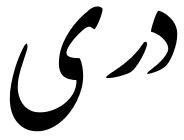Language/Dari/Grammar/Basic-Prepositions
Introduction to Basic Prepositions in Dari
Prepositions are an important part of any language as they help us to express time, place, and direction. In Dari, prepositions are used extensively to form meaningful sentences. In this lesson, we will learn the most common prepositions in Dari, their meanings, and how to use them correctly in sentences. Let's get started!
What are Prepositions?
A preposition is a word that shows the relationship between a noun and other words in a sentence. Prepositions are used to indicate position, direction, time, manner, or purpose.
In Dari, prepositions are usually placed before the noun or pronoun they describe. In some cases, however, the preposition can also be placed at the end of the sentence.
Common Prepositions in Dari
Here are some of the most commonly used prepositions in Dari along with their meanings and examples:
| Dari | Pronunciation | English Translation |
|---|---|---|
| به | bé | to |
| از | az | from |
| برای | baráy | for |
| در | dar | in, at |
| با | bá | with |
| روی | ruy | on, upon |
| پشت | pasht | behind |
| جلوی | jelawí | in front of, ahead of |
| در میان | dar míyán | in the middle of, among |
| بالای | báláy | above, over |
| زیر | zír | under, beneath |
| نزدیک | nazdík | near, close to |
| دور از | dor áz | far from |
It is important to note that the meaning of a preposition can change based on the context in which it is used. Therefore, it is essential to understand the entire sentence to know the exact meaning of the preposition.
Using Prepositions in Sentences
Prepositions are used to describe the relationship between a noun and other words in a sentence. Here are some examples of how prepositions can be used in sentences:
- من به کلاس می روم. (Man bé kelás mirawam.) - I am going to the class.
- آنها با دوستانشان ملاقات می کنند. (Ánhā bá dóstánashán meláqát mikonand.) - They are meeting with their friends.
- کتاب روی میز است. (Ketáb ruy miz ast.) - The book is on the table.
- ما در خانه می نشینیم. (Má dar kháneh mí neshínum.) - We are sitting at home.
- آن دختر در مدرسه می خواند. (Án dokhtar dar madrese mi kháwand.) - That girl is studying in school.
As you can see from the examples above, prepositions are an essential part of sentence construction in Dari. They help to convey the correct meaning and convey the relationship between the noun and other words in the sentence.
Conclusion
In this lesson, we learned about the most common prepositions used in Dari, their meanings, and how to use them correctly in sentences. It is essential to understand the meaning of prepositions to form meaningful sentences correctly. In the next lesson, we will learn about conjunctions, which are used to connect words, phrases, and clauses in sentences.
Well done on mastering this lesson! Don't miss these related pages to expand your knowledge: Gender & Basic Verb Conjugation.
Other Lessons
- Personal Pronouns
- Noun Gender and Plurals
- Future Tense
- Plurals
- Negation
- Asking Questions
- Past Tense
- Basic Verb Conjugation
- Pronouns
- Questions

